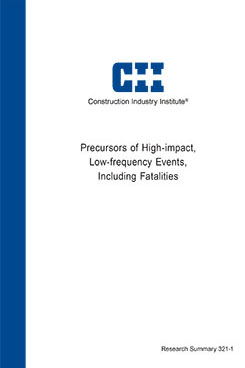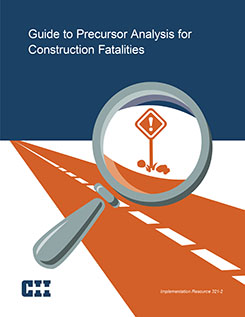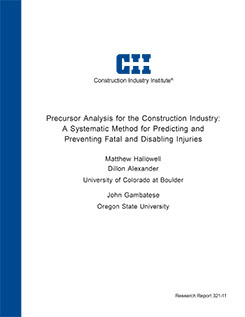
Precursors of High-Impact, Low-Frequency Events, Including Fatalities
DOCUMENT DETAILS
Abstract
Key Findings
Filters & Tags
Abstract
The ultimate goal of the Research Team 321 (RT-321) project was to conduct rigorous scientific research that yielded a precursor analysis protocol for construction that enables practitioners to pursue the following series of steps:
- Assess conditions in a leading fashion.
- Identify the presence of precursors, and quantify their extent, in a structured and methodical fashion.
- Predict and prevent the potential for a HILF event
- Are there precursors to HILF construction events?
- If so, what are they, and how can they be identified, analyzed, and used in a predictive fashion to prevent HILF events?
By using a combination of literature review, input from industry experts, empirical data collection, a series of randomized and blinded experiments, and objective multivariate statistical analyses, RT-321 was able to achieve the aforementioned goal and exceed original expectations. This project yielded the construction industry’s first valid and reliable method for identifying leading conditions that predict HILF events.
The RT-321 research process delivered the following key findings:
- The process for predicting a HILF event is far more difficult than conducting a retrospective root cause analysis.
- Precursors are different from leading indicators, and precursor analysis is different from monitoring and evaluating leading indicators.
- The quantity of that is energy present in a work operation or condition before an incident occurs is a direct predictor of the severity of an injury.
- Professionals are able to use the precursor analysis protocol developed in this research and their intuition to correctly predict the occurrence of HILF events with significantly better than random frequency.
- The errors made in prediction were most often conservative.
- Mathematical models provide a valid, reliable, and objective method for predicting the occurrence of HILF events.
- The precursors for fatalities and severe injuries are indistinguishable from those that were involved in high-energy near misses.
Key Findings
Precursor analysis involves the three-step process shown in the figure below (RS321-1, p. 4).
Step 1: Identify if high energy is present
Step 2: Assess the presence of key precursors
Step 3: Release work or stop work to make corrections
Step 1: Identify if high energy is present
Step 2: Assess the presence of key precursors
Step 3: Release work or stop work to make corrections
Filters & Tags
Knowledge Area
Research Topic
Using Precursor Analysis to Prevent Low-Frequency High-Impact Events, Including Fatalities
Keywords
Safety and health,
Precursor analysis,
Proactive safety,
Fatalities,
Probabilistic Risk Analysis,
High energy,
rt321



